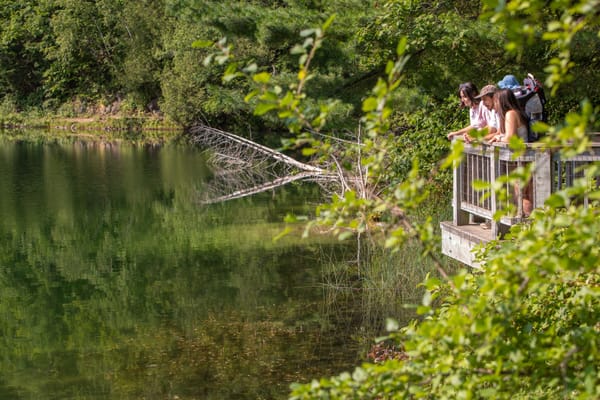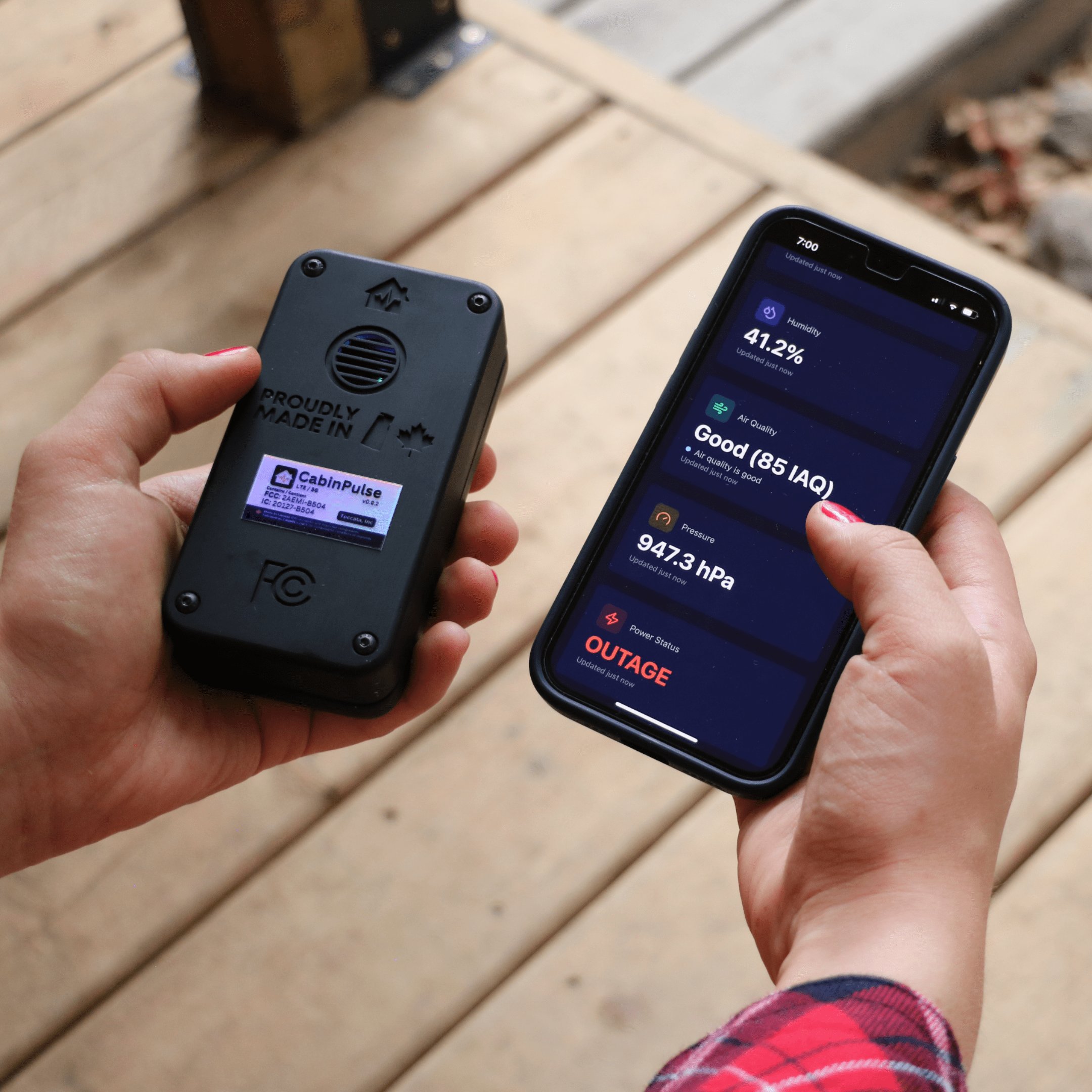<p>There's a lake in Saskatchewan where you literally can't sink. I'm not talking about doggy paddling really hard or wearing a life jacket. I mean you physically cannot go under the water even if you try.</p><p><a href="https://sasklakes.ca/little-manitou-lake-southern-zone-1/?ref=cabinliving.ca" rel="noreferrer">Little Manitou Lake</a> sits about an hour and a half southeast of Saskatoon, looking pretty unremarkable from Highway 365. Bluish-brown water, small beach, tiny village. But step into the water and physics gets weird. Your legs float up. Your body bobs like a pool noodle. You can lie back and read a book without moving a muscle.</p><figure class="kg-card kg-image-card kg-card-hascaption"><img src="https://images.unsplash.com/photo-1588627290251-20372c85461a?crop=entropy&cs=tinysrgb&fit=max&fm=jpg&ixid=M3wxMTc3M3wwfDF8c2VhcmNofDE2fHxkZWFkJTIwc2VhfGVufDB8fHx8MTc1Mjc2NjU1MHww&ixlib=rb-4.1.0&q=80&w=2000" class="kg-image" alt="woman in body of water reading book" loading="lazy" width="4032" height="3024" srcset="https://images.unsplash.com/photo-1588627290251-20372c85461a?crop=entropy&cs=tinysrgb&fit=max&fm=jpg&ixid=M3wxMTc3M3wwfDF8c2VhcmNofDE2fHxkZWFkJTIwc2VhfGVufDB8fHx8MTc1Mjc2NjU1MHww&ixlib=rb-4.1.0&q=80&w=600 600w, https://images.unsplash.com/photo-1588627290251-20372c85461a?crop=entropy&cs=tinysrgb&fit=max&fm=jpg&ixid=M3wxMTc3M3wwfDF8c2VhcmNofDE2fHxkZWFkJTIwc2VhfGVufDB8fHx8MTc1Mjc2NjU1MHww&ixlib=rb-4.1.0&q=80&w=1000 1000w, https://images.unsplash.com/photo-1588627290251-20372c85461a?crop=entropy&cs=tinysrgb&fit=max&fm=jpg&ixid=M3wxMTc3M3wwfDF8c2VhcmNofDE2fHxkZWFkJTIwc2VhfGVufDB8fHx8MTc1Mjc2NjU1MHww&ixlib=rb-4.1.0&q=80&w=1600 1600w, https://images.unsplash.com/photo-1588627290251-20372c85461a?crop=entropy&cs=tinysrgb&fit=max&fm=jpg&ixid=M3wxMTc3M3wwfDF8c2VhcmNofDE2fHxkZWFkJTIwc2VhfGVufDB8fHx8MTc1Mjc2NjU1MHww&ixlib=rb-4.1.0&q=80&w=2400 2400w" sizes="(min-width: 720px) 720px"><figcaption><span style="white-space: pre-wrap;">Photo by </span><a href="https://unsplash.com/@robinkmoore?ref=cabinliving.ca"><span style="white-space: pre-wrap;">Robin Moore</span></a></figcaption></figure><h2 id="the-science-of-not-sinking">The Science of Not Sinking</h2><p>Here's what's happening: this lake is salty as hell. We're talking <em>180 g/L</em> of salt - that's five times saltier than the ocean. All those minerals come from underground springs feeding into what geologists call a terminal lake (basically a lake with no outlet, so everything that flows in stays in).</p><figure class="kg-card kg-image-card kg-card-hascaption"><img src="https://images.unsplash.com/photo-1606588347049-62bfd0c118d5?crop=entropy&cs=tinysrgb&fit=max&fm=jpg&ixid=M3wxMTc3M3wwfDF8c2VhcmNofDV8fHNhbHR8ZW58MHx8fHwxNzUyNzY2NjU4fDA&ixlib=rb-4.1.0&q=80&w=2000" class="kg-image" alt="white stones on persons hand" loading="lazy" width="3000" height="4000" srcset="https://images.unsplash.com/photo-1606588347049-62bfd0c118d5?crop=entropy&cs=tinysrgb&fit=max&fm=jpg&ixid=M3wxMTc3M3wwfDF8c2VhcmNofDV8fHNhbHR8ZW58MHx8fHwxNzUyNzY2NjU4fDA&ixlib=rb-4.1.0&q=80&w=600 600w, https://images.unsplash.com/photo-1606588347049-62bfd0c118d5?crop=entropy&cs=tinysrgb&fit=max&fm=jpg&ixid=M3wxMTc3M3wwfDF8c2VhcmNofDV8fHNhbHR8ZW58MHx8fHwxNzUyNzY2NjU4fDA&ixlib=rb-4.1.0&q=80&w=1000 1000w, https://images.unsplash.com/photo-1606588347049-62bfd0c118d5?crop=entropy&cs=tinysrgb&fit=max&fm=jpg&ixid=M3wxMTc3M3wwfDF8c2VhcmNofDV8fHNhbHR8ZW58MHx8fHwxNzUyNzY2NjU4fDA&ixlib=rb-4.1.0&q=80&w=1600 1600w, https://images.unsplash.com/photo-1606588347049-62bfd0c118d5?crop=entropy&cs=tinysrgb&fit=max&fm=jpg&ixid=M3wxMTc3M3wwfDF8c2VhcmNofDV8fHNhbHR8ZW58MHx8fHwxNzUyNzY2NjU4fDA&ixlib=rb-4.1.0&q=80&w=2400 2400w" sizes="(min-width: 720px) 720px"><figcaption><span style="white-space: pre-wrap;">Photo by </span><a href="https://unsplash.com/@npi?ref=cabinliving.ca"><span style="white-space: pre-wrap;">Pavel Neznanov</span></a></figcaption></figure><p>The water gets its bronzy color from all the dissolved minerals - sodium, magnesium, potassium. On windy days, it whips up foam that piles on the shore like dirty snow. Not exactly postcard material, but the floating experience makes up for the aesthetics.</p><p>Oh, and the only things living in there? Brine shrimp. That's it. Too salty for fish, perfect for tiny crustaceans that look like sea monkeys.</p><h2 id="sacred-waters-long-before-instagram">Sacred Waters, Long Before Instagram</h2><p>Indigenous peoples figured out this lake was special way before any resort developers showed up. Dan Kennedy, an <a href="https://www.watrousheritage.ca/manitou-beach-brief-history/?ref=cabinliving.ca" rel="noreferrer">Assiniboine man of Montmartre Reserve</a> told stories about two men sick with smallpox in 1837 who recovered after bathing in the waters.</p><p>The name Manitou means Great Spirit in Cree. Tribes traveled from the Great Lakes to the Rockies to heal here. They'd put down their weapons at the water's edge - that's how sacred this place was.</p><figure class="kg-card kg-embed-card"><iframe width="200" height="113" src="https://www.youtube.com/embed/Rl_81WD2rns?feature=oembed" frameborder="0" allow="accelerometer; autoplay; clipboard-write; encrypted-media; gyroscope; picture-in-picture; web-share" referrerpolicy="strict-origin-when-cross-origin" allowfullscreen="" title="Canada's Very Own Dead Sea"></iframe></figure><p>By the 1930s, the government turned it into one of Saskatchewan's first provincial parks, part of a Depression-era job creation scheme. Hotels went up. Dance halls opened. Then the Depression killed the party for a while. The 1980s brought it back with a <a href="https://manitousprings.ca/?ref=cabinliving.ca" rel="noreferrer">proper spa</a>, and now you can float year-round in heated indoor pools (minus the brine shrimp - they filter those out).</p><h2 id="what-youll-find-today">What You'll Find Today</h2><p>Good news for 2025: the water's clean. After a rough 2022 when <a href="https://cabinliving.ca/what-every-canadian-needs-to-know-about-blue-green-algae/" rel="noreferrer">toxic algae</a> levels hit <a href="https://www.safewater.org/news/tag/Little+Manitou+Lake?ref=cabinliving.ca" rel="noreferrer">600 times the safe limit</a>, recent reports show it's all clear for swimming.</p><p>The village of Manitou Beach (population: 300) knows exactly what it is. There's Danceland, where you can still catch live bands. The Salty Cinema Drive-In Theatre, because Saskatchewan still does drive-ins right. Golf course, campground, restaurants that know their way around a burger.</p><p>The main attraction is <a href="https://manitousprings.ca/?ref=cabinliving.ca" rel="noreferrer">Manitou Springs Resort</a> with its "Canada's largest indoor mineral spa". They've got 102 rooms and pools heated between 93 and 103 degrees. Perfect for February when it's minus-thirty outside and you want to pretend you're somewhere tropical.</p><figure class="kg-card kg-image-card kg-card-hascaption"><img src="https://cabinliving.ca/content/images/2025/07/image-81.png" class="kg-image" alt="" loading="lazy" width="1466" height="874" srcset="https://cabinliving.ca/content/images/size/w600/2025/07/image-81.png 600w, https://cabinliving.ca/content/images/size/w1000/2025/07/image-81.png 1000w, https://cabinliving.ca/content/images/2025/07/image-81.png 1466w" sizes="(min-width: 720px) 720px"><figcaption><span style="white-space: pre-wrap;">Manitou Springs Resort</span></figcaption></figure><h2 id="why-it-works">Why It Works</h2><p>Look, I'm not here to sell you on miracle cures. The water won't fix your bad knee or make you look ten years younger. What it will do is let you float effortlessly in warm, mineral-rich water while snow falls outside.</p><blockquote>"I can't believe I've lived my entire life in Saskatchewan and didn't know about our very own Dead Sea.</blockquote><p>Skip the crowds at the actual Dead Sea. Our version might be half as salty, but it's got that Canadian charm - unpretentious, hiding in plain sight on the Saskatchewan prairie. Plus, you can grab a beer at <a href="https://www.tripadvisor.ca/Restaurant_Review-g3902996-d10049203-Reviews-Mikes_Beach_Bar-Manitou_Beach_Saskatchewan.html?ref=cabinliving.ca" rel="noreferrer">Mike's</a> afterward without dealing with international roaming charges.</p><p>Just don't open your mouth underwater. Seriously. That's 180 grams per litre of regret right there.</p>
<p>A wildfire that started Monday afternoon near Chance Harbour on the Bonavista Peninsula has destroyed an undetermined number of cabins and grown to 1,200 hectares, making it the largest active fire in Newfoundland and Labrador, according to provincial officials.</p><p>Provincial fire duty officer Mark Lawlor <a href="https://www.cbc.ca/news/canada/newfoundland-labrador/chance-harbour-fire-update-tuesday-1.7585171?ref=cabinliving.ca" rel="noreferrer">told CBC News</a> that the fire began early Monday afternoon and rapidly expanded from zero to 500 hectares within hours, then doubled overnight to 1,200 hectares by Tuesday morning.</p><p>The Department of Fisheries, Forestry and Agriculture reported the fire covered approximately 12 square kilometres as of Monday night. The blaze remains out of control, according to the provincial fire dashboard.</p><p>Citing wind, warm temperatures, and low humidity as contributing factors, Lawlor said,</p><blockquote>"The conditions were perfect for it" </blockquote><figure class="kg-card kg-image-card"><img src="https://cabinliving.ca/content/images/2025/07/image-76.png" class="kg-image" alt="" loading="lazy" width="2000" height="1265" srcset="https://cabinliving.ca/content/images/size/w600/2025/07/image-76.png 600w, https://cabinliving.ca/content/images/size/w1000/2025/07/image-76.png 1000w, https://cabinliving.ca/content/images/size/w1600/2025/07/image-76.png 1600w, https://cabinliving.ca/content/images/size/w2400/2025/07/image-76.png 2400w" sizes="(min-width: 720px) 720px"></figure><h2 id="evacuations-and-property-damage">Evacuations and Property Damage</h2><p>An evacuation order was issued Monday for the Chance Harbour Resource Road cabin area. Multiple cabin owners reported fleeing by boat after spotting smoke and hearing water bombers overhead.</p><blockquote>"I could smell smoke, but I couldn't see it" </blockquote><p>Cabin owner Patsy Humby <a href="https://www.cbc.ca/news/canada/newfoundland-labrador/wildfires-nl-july14-1.7584524?ref=cabinliving.ca" rel="noreferrer">told CBC News</a>, "I thought, 'Oh my gosh, I think we're in trouble.' It was big."</p><figure class="kg-card kg-image-card kg-card-hascaption"><img src="https://cabinliving.ca/content/images/2025/07/0b3165fc-ab6b-42af-a9cc-671c6f474378.png" class="kg-image" alt="" loading="lazy" width="2000" height="1421" srcset="https://cabinliving.ca/content/images/size/w600/2025/07/0b3165fc-ab6b-42af-a9cc-671c6f474378.png 600w, https://cabinliving.ca/content/images/size/w1000/2025/07/0b3165fc-ab6b-42af-a9cc-671c6f474378.png 1000w, https://cabinliving.ca/content/images/size/w1600/2025/07/0b3165fc-ab6b-42af-a9cc-671c6f474378.png 1600w, https://cabinliving.ca/content/images/2025/07/0b3165fc-ab6b-42af-a9cc-671c6f474378.png 2274w" sizes="(min-width: 720px) 720px"><figcaption><span style="white-space: pre-wrap;">Photo captured from a social media video shared by Ryan Pitts</span></figcaption></figure><p>Ryan Pitts, a local resident who surveyed the area by boat Tuesday morning, reported via social media that most cabins in the Puddin' Cove area had been destroyed, while Warricks Cove remained mostly intact.</p><p>"A lot of cabins lost. Out of 20 or 21 in Puddin' Cove there is only 2 left," Pitts wrote on social media.</p><blockquote>"By the time I got out there, it was just consuming everything," </blockquote><p><a href="https://www.cbc.ca/news/canada/newfoundland-labrador/chance-harbour-fire-update-tuesday-1.7585171?ref=cabinliving.ca#:~:text=Pitts%20said%20he%20got%20one,there's%20nothing%20you%20can%20do.%22" rel="noreferrer">Describing</a> his attempt to help evacuate cabin owners Monday, Pitts said, "What can you say? You're watching it all burn and there's nothing you can do."</p><figure class="kg-card kg-embed-card"><iframe width="200" height="113" src="https://www.youtube.com/embed/bPyMORY1TQE?feature=oembed" frameborder="0" allow="accelerometer; autoplay; clipboard-write; encrypted-media; gyroscope; picture-in-picture; web-share" referrerpolicy="strict-origin-when-cross-origin" allowfullscreen="" title="DEVASTATION Hits Home - Pudding Cove Area Forest Fire Newfoundland July 15th, 2025"></iframe></figure><h2 id="fire-response">Fire Response</h2><p>Three water bombers, one helicopter, a bird dog aircraft, and ground crews are fighting the fire, with an incident management team in place, according to the Department of Fisheries, Forestry and Agriculture.</p><p>The Lethbridge and Area Volunteer Fire Department reported it was on scene supporting forestry crews.</p><p>Lawlor said the fire is moving northeast toward the coast, away from the communities of Jamestown and Winterbrook, which are 5.5 and 6.3 kilometres from the fire respectively.</p><h2 id="provincial-fire-situation">Provincial Fire Situation</h2><p>The Chance Harbour fire is one of nine active wildfires burning in Newfoundland and Labrador as of Tuesday morning, with two classified as out of control. A provincewide fire ban implemented Friday remains in effect.</p><p>Other active fires include:</p><ul><li>Northwest Brook: 1,000 hectares, out of control</li><li>Pamehac Brook North (Badger): 1,034 hectares, under control</li><li>Burnt Dam 1: 131 hectares, being held</li><li>Maccles Lake South: 2.3 hectares, under control</li></ul><p>The province has recorded 160 active fires so far this year.</p><h2 id="ongoing-concerns">Ongoing Concerns</h2><p>With temperatures forecast to remain in the high 20s to 30s Celsius, that extreme fire behavior is expected to continue. Lawlor told CBC Radio's <em>The St. John's Morning Show</em>,</p><blockquote>"It looks pretty well like we're going to have three nice days … so I can't really predict [a return to cabins]"</blockquote><p>The Department of Fisheries, Forestry and Agriculture suspended all forest harvesting operating permits in areas where the Fire Weather Index is extreme, effective immediately.</p><p>Newfoundland and Labrador has the highest concentration of cabins in Canada, with approximately <a href="https://cabinliving.ca/which-province-has-the-most-cabins/">90 cabins per 1,000 people</a>.</p><p><em>The cause of the Chance Harbour fire remains under investigation.</em></p><hr><p><em>Main Image by Ryan Pitts</em></p>
<p>Nothing captures the imagination quite like a private island. The appeal is primal - your own piece of land, surrounded by water. In Georgian Bay, this isolation takes on a particular character. </p><p>The Bay's granite shores and wind-bent pines haven't changed much since the first cottagers arrived by steamship in the early 1900s. Those original families built structures meant to endure; fieldstone fireplaces, hand-hewn beams, deep porches facing west toward the sunset. </p><p>These century-old cottages, when they survive, represent something increasingly rare - not just waterfront property, but a direct connection to Canadian cabin culture's golden age.</p><figure class="kg-card kg-image-card"><img src="https://cabinliving.ca/content/images/2025/07/image-8.png" class="kg-image" alt="" loading="lazy" width="1360" height="1018" srcset="https://cabinliving.ca/content/images/size/w600/2025/07/image-8.png 600w, https://cabinliving.ca/content/images/size/w1000/2025/07/image-8.png 1000w, https://cabinliving.ca/content/images/2025/07/image-8.png 1360w" sizes="(min-width: 720px) 720px"></figure><h3 id="now-theres-one-for-sale">Now, there's one for sale. </h3><p><strong>Porcupine Island</strong> sits in the heart of Georgian Bay, 1.4 acres of Canadian Shield with a lakehouse dating to 1914. The property underwent an artful restoration in 2012 that managed something difficult - preserving details that matter while quietly adding the modern luxuries that make island living comfortable year-round. </p><figure class="kg-card kg-image-card"><img src="https://cabinliving.ca/content/images/2025/07/image-7.png" class="kg-image" alt="" loading="lazy" width="1360" height="1018" srcset="https://cabinliving.ca/content/images/size/w600/2025/07/image-7.png 600w, https://cabinliving.ca/content/images/size/w1000/2025/07/image-7.png 1000w, https://cabinliving.ca/content/images/2025/07/image-7.png 1360w" sizes="(min-width: 720px) 720px"></figure><p>The project clearly required both deep pockets and patience. Modern infrastructure was masterfully threaded through 110-year-old bones without disturbing what makes the place special.</p><p></p><figure class="kg-card kg-image-card"><img src="https://cabinliving.ca/content/images/2025/07/image-10.png" class="kg-image" alt="" loading="lazy" width="1360" height="906" srcset="https://cabinliving.ca/content/images/size/w600/2025/07/image-10.png 600w, https://cabinliving.ca/content/images/size/w1000/2025/07/image-10.png 1000w, https://cabinliving.ca/content/images/2025/07/image-10.png 1360w" sizes="(min-width: 720px) 720px"></figure><p>The restoration added practical elements like a 3-ton heat pump, heated floors, and a chef's kitchen. </p><figure class="kg-card kg-gallery-card kg-width-wide"><div class="kg-gallery-container"><div class="kg-gallery-row"><div class="kg-gallery-image"><img src="https://cabinliving.ca/content/images/2025/07/image-17.png" width="1360" height="907" loading="lazy" alt="" srcset="https://cabinliving.ca/content/images/size/w600/2025/07/image-17.png 600w, https://cabinliving.ca/content/images/size/w1000/2025/07/image-17.png 1000w, https://cabinliving.ca/content/images/2025/07/image-17.png 1360w" sizes="(min-width: 720px) 720px"></div><div class="kg-gallery-image"><img src="https://cabinliving.ca/content/images/2025/07/image-18.png" width="1360" height="907" loading="lazy" alt="" srcset="https://cabinliving.ca/content/images/size/w600/2025/07/image-18.png 600w, https://cabinliving.ca/content/images/size/w1000/2025/07/image-18.png 1000w, https://cabinliving.ca/content/images/2025/07/image-18.png 1360w" sizes="(min-width: 720px) 720px"></div></div></div></figure><figure class="kg-card kg-image-card"><img src="https://cabinliving.ca/content/images/2025/07/image-15.png" class="kg-image" alt="" loading="lazy" width="1360" height="907" srcset="https://cabinliving.ca/content/images/size/w600/2025/07/image-15.png 600w, https://cabinliving.ca/content/images/size/w1000/2025/07/image-15.png 1000w, https://cabinliving.ca/content/images/2025/07/image-15.png 1360w" sizes="(min-width: 720px) 720px"></figure><p>But the original home's character remains untouched: the stacked stone fireplace, the dining room's wall of paned windows, the full-length screened porch that cottage purists consider non-negotiable.</p><figure class="kg-card kg-gallery-card kg-width-wide"><div class="kg-gallery-container"><div class="kg-gallery-row"><div class="kg-gallery-image"><img src="https://cabinliving.ca/content/images/2025/07/image-12.png" width="1360" height="907" loading="lazy" alt="" srcset="https://cabinliving.ca/content/images/size/w600/2025/07/image-12.png 600w, https://cabinliving.ca/content/images/size/w1000/2025/07/image-12.png 1000w, https://cabinliving.ca/content/images/2025/07/image-12.png 1360w" sizes="(min-width: 720px) 720px"></div><div class="kg-gallery-image"><img src="https://cabinliving.ca/content/images/2025/07/image-13.png" width="1360" height="907" loading="lazy" alt="" srcset="https://cabinliving.ca/content/images/size/w600/2025/07/image-13.png 600w, https://cabinliving.ca/content/images/size/w1000/2025/07/image-13.png 1000w, https://cabinliving.ca/content/images/2025/07/image-13.png 1360w" sizes="(min-width: 720px) 720px"></div></div></div></figure><p>The addition, built at right angles to the original structure, houses the modern amenities: the kitchen, a main floor office, laundry facilities. </p><figure class="kg-card kg-image-card"><img src="https://cabinliving.ca/content/images/2025/07/image-16.png" class="kg-image" alt="" loading="lazy" width="1360" height="906" srcset="https://cabinliving.ca/content/images/size/w600/2025/07/image-16.png 600w, https://cabinliving.ca/content/images/size/w1000/2025/07/image-16.png 1000w, https://cabinliving.ca/content/images/2025/07/image-16.png 1360w" sizes="(min-width: 720px) 720px"></figure><p>The new doesn't compete with the old, and a metal roof covers everything, ready for Georgian Bay's weather extremes.</p><figure class="kg-card kg-image-card"><img src="https://cabinliving.ca/content/images/2025/07/image-22.png" class="kg-image" alt="" loading="lazy" width="1360" height="907" srcset="https://cabinliving.ca/content/images/size/w600/2025/07/image-22.png 600w, https://cabinliving.ca/content/images/size/w1000/2025/07/image-22.png 1000w, https://cabinliving.ca/content/images/2025/07/image-22.png 1360w" sizes="(min-width: 720px) 720px"></figure><p>Outside, the property reveals why this particular corner of the Bay draws repeat visitors. Multi-tiered decks face west for sunset viewing. The hot tub placement takes advantage of both privacy and views.</p><figure class="kg-card kg-image-card"><img src="https://cabinliving.ca/content/images/2025/07/image-21.png" class="kg-image" alt="" loading="lazy" width="1360" height="907" srcset="https://cabinliving.ca/content/images/size/w600/2025/07/image-21.png 600w, https://cabinliving.ca/content/images/size/w1000/2025/07/image-21.png 1000w, https://cabinliving.ca/content/images/2025/07/image-21.png 1360w" sizes="(min-width: 720px) 720px"></figure><p>Boardwalks wind through perennial gardens, connecting seating areas scattered across the island. </p><figure class="kg-card kg-gallery-card kg-width-wide"><div class="kg-gallery-container"><div class="kg-gallery-row"><div class="kg-gallery-image"><img src="https://cabinliving.ca/content/images/2025/07/image-23.png" width="1360" height="1018" loading="lazy" alt="" srcset="https://cabinliving.ca/content/images/size/w600/2025/07/image-23.png 600w, https://cabinliving.ca/content/images/size/w1000/2025/07/image-23.png 1000w, https://cabinliving.ca/content/images/2025/07/image-23.png 1360w" sizes="(min-width: 720px) 720px"></div><div class="kg-gallery-image"><img src="https://cabinliving.ca/content/images/2025/07/image-9.png" width="1360" height="1018" loading="lazy" alt="" srcset="https://cabinliving.ca/content/images/size/w600/2025/07/image-9.png 600w, https://cabinliving.ca/content/images/size/w1000/2025/07/image-9.png 1000w, https://cabinliving.ca/content/images/2025/07/image-9.png 1360w" sizes="(min-width: 720px) 720px"></div></div></div></figure><p>The boathouse sits protected behind a natural shoal breakwater - a geographical gift for any Georgian Bay property. Recent rebuilding included new cribs, docks, and roofing. For an island property, protected docking might be the most valuable amenity of all.</p><figure class="kg-card kg-image-card"><img src="https://cabinliving.ca/content/images/2025/07/image-24.png" class="kg-image" alt="" loading="lazy" width="1360" height="907" srcset="https://cabinliving.ca/content/images/size/w600/2025/07/image-24.png 600w, https://cabinliving.ca/content/images/size/w1000/2025/07/image-24.png 1000w, https://cabinliving.ca/content/images/2025/07/image-24.png 1360w" sizes="(min-width: 720px) 720px"></figure><p>Georgian Bay presents specific challenges. Water levels fluctuate. Winter ice can be destructive. Storm waves from open water reach impressive heights. This property's position offers long views while remaining sheltered from the worst of the big water - a rare combination.</p><figure class="kg-card kg-image-card"><img src="https://cabinliving.ca/content/images/2025/07/image-25.png" class="kg-image" alt="" loading="lazy" width="1360" height="907" srcset="https://cabinliving.ca/content/images/size/w600/2025/07/image-25.png 600w, https://cabinliving.ca/content/images/size/w1000/2025/07/image-25.png 1000w, https://cabinliving.ca/content/images/2025/07/image-25.png 1360w" sizes="(min-width: 720px) 720px"></figure><p>Georgian Bay's proximity to Toronto (about 2 hours north) puts it within weekend reach of millions seeking authentic cottage experiences.</p><p>Private island sales in Ontario follow standard real estate processes, with one key difference: access. Buyers need to factor in boat transportation for everything from groceries to building materials. Winter access depends on ice conditions, increasingly unpredictable in recent years.</p><figure class="kg-card kg-image-card"><img src="https://cabinliving.ca/content/images/2025/07/image-26.png" class="kg-image" alt="" loading="lazy" width="1360" height="907" srcset="https://cabinliving.ca/content/images/size/w600/2025/07/image-26.png 600w, https://cabinliving.ca/content/images/size/w1000/2025/07/image-26.png 1000w, https://cabinliving.ca/content/images/2025/07/image-26.png 1360w" sizes="(min-width: 720px) 720px"></figure><p>The price remains unlisted - which is standard practice for unique Georgian Bay properties where comparables rarely exist. You can be certain the price falls comfortably into the 7 figures. </p><p>The freehold title means full ownership, avoiding lease complications common with some Canadian island properties.</p><hr><p></p><p>Porcupine Island exists in that sweet spot of island real estate: beautifully developed to be immediately usable, remote enough to feel like an escape, close enough to be practical. </p><p>Whether it becomes a summer base, three-season retreat, or rental investment will depend on who appreciates the unique alchemy of old bones and new upgrades on a patch of rock in one of Canada's most storied bodies of water.</p><p><em>View the listing or inquire about the property at </em><a href="https://www.privateislandsonline.com/canada/ontario/georgian-bay/porcupine-island?ref=cabinliving.ca" rel="noreferrer"><em>PrivateIslandsOnline.com</em></a></p><figure class="kg-card kg-embed-card"><iframe width="200" height="113" src="https://www.youtube.com/embed/SjC80g18sts?feature=oembed" frameborder="0" allow="accelerometer; autoplay; clipboard-write; encrypted-media; gyroscope; picture-in-picture; web-share" referrerpolicy="strict-origin-when-cross-origin" allowfullscreen="" title="Porcupine Island"></iframe></figure><p><em>Duration: 3:21 | All images credit </em><a href="https://www.privateislandsonline.com/canada/ontario/georgian-bay/porcupine-island?ref=cabinliving.ca" rel="noreferrer"><em>PrivateIslandsOnline.com</em></a></p>
<p>There's nothing like a view of the Canadian outdoors - it's part of what makes cabin living so special. Unfortunately, you can't always be up at the cottage to enjoy it.</p><p>I recently came across three webcams from different parts of Canada that give a live view of the great outdoors. There are some pretty spectacular views to be had - and the fact they're live helps make you feel a bit more connected to nature, no matter where you're watching from.</p><p>There's even one that lets you move the camera!</p><h2 id="regina-bay-lake-of-the-woods-on">Regina Bay (Lake of the Woods, ON)</h2><figure class="kg-card kg-image-card"><a href="https://www.tomahawkresort.ca/reginabaycamera.cfm?ref=cabinliving.ca"><img src="https://cabinliving.ca/content/images/2025/06/image-22.png" class="kg-image" alt="" loading="lazy" width="2000" height="1123" srcset="https://cabinliving.ca/content/images/size/w600/2025/06/image-22.png 600w, https://cabinliving.ca/content/images/size/w1000/2025/06/image-22.png 1000w, https://cabinliving.ca/content/images/size/w1600/2025/06/image-22.png 1600w, https://cabinliving.ca/content/images/size/w2400/2025/06/image-22.png 2400w" sizes="(min-width: 720px) 720px"></a></figure><p>Our first stop takes us to Regina Bay on Lake of the Woods in Northwestern Ontario, courtesy of <a href="https://www.tomahawkresort.ca/reginabaycamera.cfm?ref=cabinliving.ca">Tomahawk Resort's interactive webcam</a>.</p><p>This isn't your average stationary camera. You actually get to <strong>control</strong> the movement and zoom in or out. Want to check if the ice is off? Zoom in on the shoreline. Curious about the sunset? Pan west and watch it live.</p><figure class="kg-card kg-image-card"><a href="https://www.tomahawkresort.ca/reginabaycamera.cfm?ref=cabinliving.ca"><img src="https://cabinliving.ca/content/images/2025/06/image-23.png" class="kg-image" alt="" loading="lazy" width="1902" height="1202" srcset="https://cabinliving.ca/content/images/size/w600/2025/06/image-23.png 600w, https://cabinliving.ca/content/images/size/w1000/2025/06/image-23.png 1000w, https://cabinliving.ca/content/images/size/w1600/2025/06/image-23.png 1600w, https://cabinliving.ca/content/images/2025/06/image-23.png 1902w" sizes="(min-width: 720px) 720px"></a></figure><p>The resort even has a message board where viewers share snapshots and fishing reports. Recent entries include "Going Fishing" and "Smoky sunrise" - classic cabin morning observations.</p><hr><p></p><h2 id="emerald-lake-lodge-yoho-national-park-bc">Emerald Lake Lodge (Yoho National Park, BC)</h2><figure class="kg-card kg-image-card"><a href="https://emeraldlakelodge.com/?ref=cabinliving.ca"><img src="https://cabinliving.ca/content/images/2025/06/image-20.png" class="kg-image" alt="" loading="lazy" width="2000" height="1122" srcset="https://cabinliving.ca/content/images/size/w600/2025/06/image-20.png 600w, https://cabinliving.ca/content/images/size/w1000/2025/06/image-20.png 1000w, https://cabinliving.ca/content/images/size/w1600/2025/06/image-20.png 1600w, https://cabinliving.ca/content/images/size/w2400/2025/06/image-20.png 2400w" sizes="(min-width: 720px) 720px"></a></figure><p>Next, we head west to <a href="https://emeraldlakelodge.com/?ref=cabinliving.ca">Emerald Lake Lodge</a> in Yoho National Park, British Columbia. While not quite "live," this webcam updates every 10 minutes from 5 a.m. to 11 p.m. Mountain Time.</p><p>The camera is mounted on the historic main lodge, facing northeast across Emerald Lake. On clear days, you'll see Emerald Peak on the left, Michael Peak in the middle, and Wapta Mountain on the right.</p><p>Any points it loses for not being 'live' it makes up for in Canadian mountain beauty. Look at that turquoise water!</p><h2 id="algonquin-provincial-park-on">Algonquin Provincial Park (ON)</h2><figure class="kg-card kg-image-card"><a href="https://www.youtube.com/watch?v=QX9OfclWZuM&ref=cabinliving.ca"><img src="https://cabinliving.ca/content/images/2025/06/image-21.png" class="kg-image" alt="" loading="lazy" width="2000" height="1115" srcset="https://cabinliving.ca/content/images/size/w600/2025/06/image-21.png 600w, https://cabinliving.ca/content/images/size/w1000/2025/06/image-21.png 1000w, https://cabinliving.ca/content/images/size/w1600/2025/06/image-21.png 1600w, https://cabinliving.ca/content/images/size/w2400/2025/06/image-21.png 2400w" sizes="(min-width: 720px) 720px"></a></figure><p>Our final destination brings us to one of Ontario's better known destinations: <a href="https://www.youtube.com/watch?v=QX9OfclWZuM&ref=cabinliving.ca">Algonquin Provincial Park</a>. The <a href="https://www.algonquinpark.on.ca/foap/?ref=cabinliving.ca" rel="noreferrer">Friends of Algonquin Park</a> have set up a spectacular 4K live stream from the Visitor Centre.</p><p>What sets this one apart? You can rewind up to 12 hours. Missed that moose that wandered by this morning? Just scroll back. Want to watch yesterday's thunderstorm roll across Fork Lake? It's all there.</p><figure class="kg-card kg-embed-card"><iframe width="200" height="113" src="https://www.youtube.com/embed/QX9OfclWZuM?feature=oembed" frameborder="0" allow="accelerometer; autoplay; clipboard-write; encrypted-media; gyroscope; picture-in-picture; web-share" referrerpolicy="strict-origin-when-cross-origin" allowfullscreen="" title="Algonquin Park Live Webcam | Ontario, Canada | www.algonquinpark.on.ca"></iframe></figure><p>The panoramic view showcases everything Algonquin is famous for – coniferous forests, deciduous stands, spruce bog, Fork Lake, and Sunday Creek. During fall, it's absolutely electric with color. In winter, it's a snow globe come to life. </p><p>And if you're lucky, you might catch some wildlife.</p>













/Phone%20and%20computer%20internet%20network.jpg)